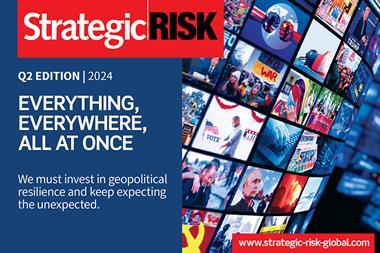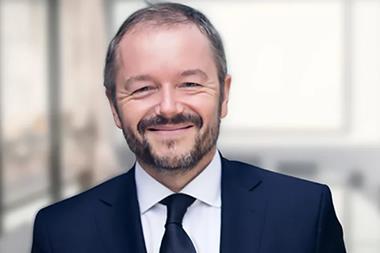Sara Byrne, regional head of operational risk, Property, Standard Chartered, has navigated an unusual route into the risk management profession
Sara Byrne, regional head of operational risk, Property, Standard Chartered, has navigated an unusual route into the risk management profession. While most risk professionals start in the accounting and audit fields, Byrne began her career in her native Australia as a flight instructor.
The precocious pilot started flying at the age of 15 and held a license aged just 16, even before she could drive a car. In her home city of Brisbane, Byrne took to the skies with her father and developed a long-lasting love for aviation.
“It was something I could do with my dad, and when it came time to pick a career path, I ended up in that world and started on that journey.” Byrne flew mainly light aircraft, single-engine Cessna 152s, 172s, and 182s, and mastered the art quickly to become a qualified instructor.
After a spell in the skies, Byrne’s journey to the risk management sector began. After moving on from her role as an instructor, she joined airline Virgin Blue as a flight operations and technical support officer. She spent several years at the company, and then worked as a flight standards coordinator and airside standards advisor, dealing with safety and standards issues.
“At Virgin Blue [now part of Virgin Australia], my first role was helping to write programmes for pilots and running simulators, similar to what I’d done in the instructor world. I then moved across various roles in the company. Airlines are very risk-focused. At an airline, the top priority is safety. The process to achieve that is risk management.”
Sara says her time flying helped her lay the groundwork for a career in strategic risk: “When you are flying, you’re making risk-based decisions on the information you have in front of you in real time,” Byrne says. “My time flying definitely helped cement a risk methodology.”
A flying start
The safety-conscious airline sector proved to be a perfect training ground for a career in risk management. Byrne eventually left Australia and Virgin to work for Hong Kong flag carrier Cathay Pacific as an in-flight safety and standards manager, and then Jetstar, working on safety, security and risk roles.
“The aviation sector has always been very risk-based,” Byrne says. “Managing compliance and safety requirements, and having to demonstrate these to international and regulatory bodies. The technical side is very ingrained. But the cabin crew side was more challenging as they balance service and safety. Initially, cabin crew were there to keep passengers calm, and the role evolved over the past 100-plus years. Their primary duty is the safety of the passenger. So I found the work we did with cabin crew particularly rewarding.”
One of Byrne’s biggest achievements at Cathay Pacific was fostering a culture of independent and critical thinking around risk. Staff were encouraged to follow risk management processes, but in difficult situations, were encouraged to be creative to achieve the best outcomes for the company and its passengers with an overarching risk-based approach to decision-making.
“As an example, they had passengers who needed to carry large, expensive instruments, which were insured for millions of dollars. On one occasion, the crew didn’t have the right equipment to secure an instrument. So they had to work with the engineering and flight crew to secure it. They had to be creative.”
Byrne rejoined Cathay Pacific for a second spell, holding the role of group safety resilience manager until early 2019. She sympathises with the airline sector during COVID-19, and says airlines will struggle to find the “balance between production and protection” once people start flying again.
“The social distancing aspects are difficult on an aeroplane, unfortunately,” she says. “There was a study done that suggested if you keep people two metres or 1.5 metres apart, a 737 is reduced from 180 seats to 30-odd seats. As you can imagine, that’s not sustainable.”
She adds: “Every industry has inherent risks, and there are emerging risks. The assumption around inherent risks in that industry is very different now.”
Between 2014 and 2017, Byrne studied for an MBA with the aim of moving out of the airline sector into the broader risk management industry. She encountered some barriers on the way, with companies and recruiters wanting specific industry experience. Eventually, she landed in Hong Kong at one of Asia’s leading financial institutions.
“I’d been in the aviation industry for some time and wanted to do something different,” she says. “I saw there was a different way to demonstrate my skills, and that they were transferable to other sectors. Eventually, I came across my current employer in the financial sector, and a boss who wanted someone from outside of the banking industry.”
She believes there are plenty of parallels between risk management in the aviation sector and the financial world. She adds there are plenty of lessons finance can learn from the safety-first airline industry and vice versa.
“I’ve found in the banking industry, while there are lots of layers of defence and there are operational risk methodologies, people struggle to articulate the risk they are trying to mitigate. You need to be very specific about the worst foreseeable outcome of a hazard and be clear on what you need to do to mitigate it.”
“It’s about having better risk knowledge, the right language and understanding the difference between a hazard and a risk,” she adds. “When you’re in front of auditors or compliance, making sure you’re using the right words.”
Getting the culture right
In her banking role, Byrne is excited about introducing the concept of ‘Just Culture’, encouraging a more collaborative approach to risk from people across the business. She wants front-line staff to express potential risk concerns and wants employees to “balance accountability with learning”.
She adds: “Companies set people up in a process and system to do a job, but we know those systems aren’t perfect. If we only look at the last layer of defence, people, and don’t look further upstream at how the error occurred, we are never going to fix the problem.
“The concept is very big in aviation. If there’s a heavy landing, and the crew don’t tell engineering about it, they put the next flight at risk. So there’s an open forum where you’re encouraged and even rewarded to put your hand up.”
Byrne is trying to introduce ‘Just Culture’ into the banking world: “It looks at how we set individuals up for success. How do we set them up for failure?“Are we getting them to do something they are not trained for? Are our processes not clear? Is our training not effective? It’s having some early interest and successes. It’s not a silver bullet, but it will hopefully lead to more effective risk mitigation, as we will not just be focused on the last line of defence but all layers of defence: people, process, systems and environment.”
Culture is particularly important in the Asia-Pacific financial sector in 2020, with increased regulatory focus on banks, and poor conduct highlighted by Australia’s Royal Commission into financial services. Byrne says a strong risk culture is equally important in the heavily regulated aviation and financial sectors.
“The Royal Commission talked to culture as one of the reasons the financial institutions ended up where they were,” she says. “You need to set up an environment in your organisation where people do the right thing, and you set them up to do the right thing. That is exactly what ‘Just Culture’ tries to get people to do, with accountability and learning.”
“In the aviation industry it is regulated that you have to have a ‘Just’ culture, because there’s loss of life risk if a crew member does something and doesn’t tell someone. The risk is quite high. In the banking world, we’re not talking about loss of life, but we are talking about loss of revenue, money, confidence. They’re also very important.”
With changes underway at Byrne’s bank, she would like to see a different corporate approach to risk in the next few years.
“I would like to see a shift. We’re not there to be the police; we’re there to help businesses achieve objectives,” she says. “We navigate that space between production and protection. We help businesses find out what the boundary looks like, and businesses should leverage that capability.
“Other areas within companies, like legal or compliance, don’t have as much flexibility as us. But in risk, we navigate that space. If we’re brought into conversations early, we can help inform better business decisions.”
After changing the face of risk management in the skies, Byrne is ready for the city.




















No comments yet